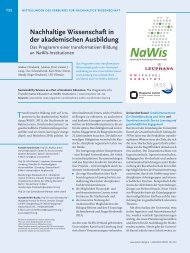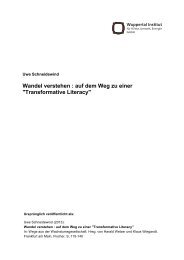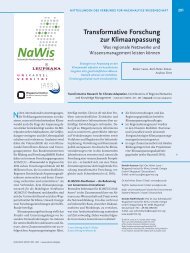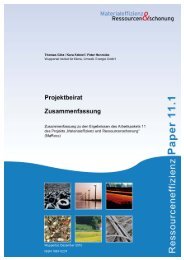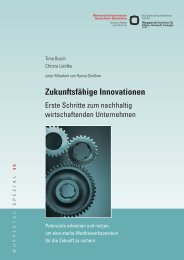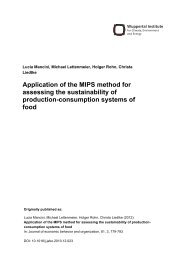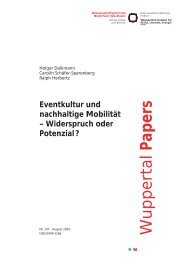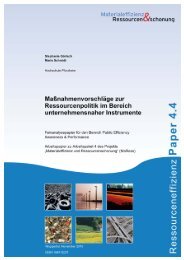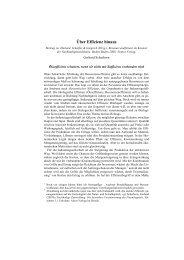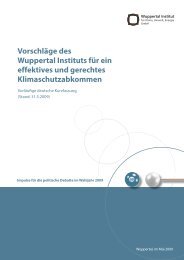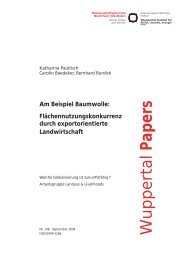Resource Efficiency Atlas - Publication Server of the Wuppertal ...
Resource Efficiency Atlas - Publication Server of the Wuppertal ...
Resource Efficiency Atlas - Publication Server of the Wuppertal ...
You also want an ePaper? Increase the reach of your titles
YUMPU automatically turns print PDFs into web optimized ePapers that Google loves.
and products might be restricted due to <strong>the</strong>ir very specific<br />
field <strong>of</strong> application. Technologies saving resources during<br />
<strong>the</strong> use phase are unlikely to realize <strong>the</strong>ir full potential if<br />
sold only in niche markets. This factor should be taken into<br />
account when promoting resource efficient technologies<br />
and products.<br />
The same holds for technical solutions with high invest-<br />
ment costs. The risk derives from <strong>the</strong> solution remaining<br />
in a niche market even if <strong>the</strong> use is economically feasible<br />
in <strong>the</strong> long run. Therefore, appropriate forms <strong>of</strong> promotion<br />
and funding need to be implemented by policies to counteract<br />
<strong>the</strong>se risks.<br />
In general, <strong>the</strong> results <strong>of</strong> <strong>the</strong> SWOT-analysis show that<br />
resource efficient technologies and products can only<br />
4.2 Strategic starting points and courses <strong>of</strong> action<br />
In light <strong>of</strong> <strong>the</strong> need to implement resource efficiency due<br />
to environmental reasons <strong>the</strong> question needs to be raised:<br />
Why is <strong>the</strong>re only a limited amount <strong>of</strong> resource efficient<br />
technical solutions applied today? This question was intensively<br />
discussed in <strong>the</strong> expert workshop. The main<br />
problem is attributed to market failure: Today most raw<br />
material prices do not reflect ecological and social costs<br />
(external costs) resulting from raw material extraction and<br />
flows (e.g. water and air contamination, health risks, soil<br />
erosion). Therefore, <strong>the</strong> use <strong>of</strong> resources along <strong>the</strong> entire<br />
value chain is rarely leading to economic advantages for<br />
companies and consumers. As most <strong>of</strong> <strong>the</strong> interviewed<br />
experts confirm, more information on <strong>the</strong> benefits <strong>of</strong> resource<br />
efficient technological solutions is needed - even if<br />
financial incentives are missing.<br />
Capturing existing potentials<br />
Under current economic framework conditions numerous<br />
technical solutions are already economically feasible and<br />
do not depend on supportive policy measures. Some <strong>of</strong> <strong>the</strong><br />
examples in chapter 3 and <strong>the</strong> expanded collection at <strong>the</strong><br />
project’s website can be good starting points.<br />
reach <strong>the</strong>ir full potential when framework conditions<br />
promote <strong>the</strong>ir use and <strong>the</strong>ir application aims at environmental<br />
improvements. In order to meet <strong>the</strong>se conditions<br />
corresponding changes <strong>of</strong> political framework conditions<br />
are needed. This includes promotion and funding opportunities<br />
allowing manufacturers and users to make <strong>the</strong><br />
required investments. Labels indicating resource efficient<br />
products, or o<strong>the</strong>r ways <strong>of</strong> information, can create incentives<br />
for consumers. For this purpose, <strong>the</strong> current public<br />
debate focusing on climate and energy issues should be<br />
expanded to material and resource efficiency. This is also<br />
postulated by <strong>the</strong> majority <strong>of</strong> interviewed experts.<br />
One <strong>of</strong> <strong>the</strong>m is <strong>the</strong> sail system ’’Skysails’’, a relatively simple<br />
solution for reducing fuel consumption in cargo vessels<br />
(p. 46). The depth <strong>of</strong> intervention in <strong>the</strong> existing technology<br />
is low and <strong>the</strong> system works in practice. It reduces <strong>the</strong> fuel<br />
consumption <strong>of</strong> ships and needs only few adaptations.<br />
There is an especially high potential for solutions, which<br />
can be easily transferred to o<strong>the</strong>r sectors like <strong>the</strong> business<br />
model ’’Chemical Leasing’’ (p. 62). This example shows<br />
that technical solutions can be combined with appropriate<br />
business models. This is ano<strong>the</strong>r approach with high<br />
efficiency potential applicable to many o<strong>the</strong>r areas. The<br />
example is far reaching as it addresses both <strong>the</strong> production<br />
and consumption side. The risk <strong>of</strong> rebound effects is<br />
<strong>the</strong>refore low.<br />
The dissemination <strong>of</strong> existing solutions should be promoted.<br />
In order to achieve a better spread, <strong>the</strong> knowledge<br />
about present win-win solutions needs to be communicated.<br />
Many existing technical solutions are currently not<br />
applied due to inflexible patterns <strong>of</strong> thought and action.<br />
Hence, better information on solutions’ advantages is a<br />
very promising approach. Moreover, it seems to be important<br />
to convey relevant knowledge for <strong>the</strong> proper use <strong>of</strong><br />
<strong>the</strong>se technologies and products.<br />
Ressourceneffizienzatlas<br />
<strong>Resource</strong> <strong>Efficiency</strong> <strong>Atlas</strong> 71



